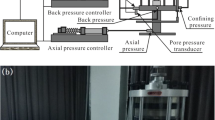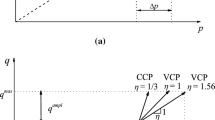Abstract
A simple critical state-based constitutive model is proposed to represent the non-coaxial plastic deformations of saturated clay subjected to monotonic shearing with fixed principal stress directions. While extensively reported in experimental studies, this particular type of soil response has not been adequately addressed by constitutive modeling. The presented model employs a revised three-dimensional non-coaxial flow rule that relies on introducing a reference stress tensor for decomposing stress rate and consequently defining the non-coaxial flow direction even when stress rate is colinear with the current stress. Undrained hollow cylinder torsional shear tests are performed on undisturbed Shanghai clay specimens. Such experimental observations, combined with complementary test results on Wenzhou clay, validate the proposed model. The comparisons show that the proposed model can reasonably represent the non-coaxial plastic flows of clays under monotonic shearing characterized by different fixed principal stress directions and various intermediate stress levels.












Similar content being viewed by others
Data availability
Some or all data, models or code that support the findings of this study are available from the corresponding author upon reasonable request.
References
Arthur J, Chua K, Dunstan T (1977) Induced anisotropy in a sand. Géotechnique 27(1):13–30
Arthur J, Menzies B (1972) Inherent anisotropy in a sand. Géotechnique 22(1):115–128
Anandarajah A, Dafalias YF (1986) Bounding surface plasticity. III: application to anisotropic cohesive soils. J Eng Mech 112(12):1292–1318
Cai Y, Yu HS, Wanatowski D, Li X (2013) Noncoaxial behavior of sand under various stress paths. J Geotech Geoenviron Eng 139(8):1381–1395
Chang JF, Li SF, Wang W, Niu QH (2021) A study of non-coaxial effects on strain localization via micropolar plasticity model. Acta Geotech. https://doi.org/10.1007/s11440-021-01291-w
Chen ZQ, Huang MS (2020) Non-coaxial behavior modeling of sands subjected to principal stress rotation. Acta Geotech 15(3):655–669
Crouch RS, Wolf JP (1995) On a three-dimensional anisotropic plasticity model for soil. Géotechnique 45(2):301–305
Dafalias YF, Manzari MT, Papadimitriou AG (2006) SANICLAY: simple anisotropic clay plasticity model. Int J Numer Anal Methods Geomech 30(12):1231–1257
Gajo A, Wood DM (2001) A new approach to anisotropic, bounding surface plasticity: general formulation and simulations of natural and reconstituted clay behaviour. Int J Numer Anal Methods Geomech 25(3):207–241
Gao ZW, Zhao JD (2016) A non-coaxial critical-state model for sand accounting for fabric anisotropy and fabric evolution. Int J Solids Struct 106–107:200–212
Gutierrez M, Ishihara K, Towhata I (1991) Flow theory for sand during rotation of principal stress direction. Soils Found 31(4):121–132
Gutierrez M, Ishihara K, Towhata I (1993) Model for the deformation of sand during rotation of principal stress directions. Soils Found 33(3):105–117
Gutierrez M, Wang J, Yoshimine M (2009) Modeling of the simple shear deformation of sand: effects of principal stress rotation. Acta Geotech 4(3):193–201
Hight D, Gens A, Symes M (1983) The development of a new hollow cylinder apparatus for investigating the effects of principal stress rotation in soils. Géotechnique 33(4):355–383
Huang MS, Liu YH (2011) Simulation of yield characteristics and principal stress rotation effects of natural soft clay. Chin J Geotech Eng 33(11):1667–1675
Huang MS, Liu YH, Sheng DC (2011) Simulation of yielding and stress–stain behavior of shanghai soft clay. Comput Geotech 38(3):341–353
Ishihara K, Towhata I (1983) Sand response to cyclic rotation of principal stress directions as induced by wave loads. Soils Found 23(4):11–26
Korhonen KH, Lojander M (1987) Yielding of Perno clay. In: Proceedings of the 2nd international conference on constitutive laws for engineering materials, pp 1249–1255
Lade (1979) Stress-strain theory for normally consolidated clay. In: 3rd international conference numerical methods geomechanics, Aachen, Germany, pp 1325–1337
Lade PV, Kirkgard MM (2000) Effects of stress rotation and changes of b-values on cross-anisotropic behavior of natural K0-consolidated soft clay. Soils Found 40(6):93–105
Lashkari A, Latifi M (2008) A non-coaxial constitutive model for sand deformation under rotation of principal stress axes. Int J Numer Anal Methods Geomech 32(9):1051–1086
Li XS, Dafalias YF (2004) A constitutive framework for anisotropic sand including non-proportional loading. Géotechnique 54(1):41–55
Li XS, Dafalias YF (2020) Noncoaxiality between two tensors with application to stress rate decomposition and fabric anisotropy variable. J Eng Mech 146(3):04020004
Ling HI, Yue D, Kaliakin VN, Themelis NJ (2002) Anisotropic elastoplastic bounding surface model for cohesive soils. J Eng Mech 128(7):748–758
Lu N, Yang YM, Yu HS, Wang Z (2020) Modelling the simple shear behaviour of clay considering principal stress rotation. Mech Res Commun 103:103474
Miura K, Miura S, Toki S (1986) Deformation behavior of anisotropic dense sand under principal stress axes rotation. Soils Found 26(1):36–52
Nakase A, Kamei T, Kusakabe O (1988) Constitutive parameters estimated by plasticity index. J Geotech Eng 114(7):844–858
Oda M, Konishi J (1974) Microscopic deformation mechanism of granular material in simple shear. Soils Found 14(4):25–38
Prashant A, Penumadu D (2015) Uncoupled dual hardening model for clays considering the effect of overconsolidation and intermediate principal stress. Acta Geotech 10(5):607–622
Qian JG, Du ZB, Lu XL, Gu XQ, Huang MS (2019) Effects of principal stress rotation on stress–strain behaviors of saturated clay under traffic–load–induced stress path. Soils Found 59(1):41–55
Qian JG, Du ZB, Yin ZY (2018) Cyclic degradation and non-coaxiality of soft clay subjected to pure rotation of principal stress directions. Acta Geotech 13(4):943–959
Qian JG, Yang J, Huang MS (2008) Three-dimensional noncoaxial plasticity modeling of shear band formation in geomaterials. J Eng Mech 134(4):322–329
Rodriguez NM, Lade PV (2014) Non-coaxiality of strain increment and stress directions in cross-anisotropic sand. Int J Solids Struct 51(5):1103–1114
Roscoe K, Bassett R, Cole E (1967) Principal axes observed during simple shear of a sand. In: Proceedings geotechnical conference on shear strength properties of nature soils and rocks, pp 231–237
Rudnicki JW, Rice JR (1975) Conditions for the localization of deformation in pressure-sensitive dilatant materials. J Mech Phys Solids 23(6):371–394
Sayao A, Vaid Y (1991) A critical assessment of stress nonuniformities in hollow cylinder test specimens. Soils Found 31(1):60–72
Schofield A, Wroth P (1968) Critical state soil mechanics. McGraw-Hill, New York
Shen Y, Du WH, Xu JH, Rui XX, Liu HL (2021) Non-coaxiality of soft clay generated by principal stress rotation under high-speed train loading. Acta Geotech. https://doi.org/10.1007/s11440-021-01242-5
Sheng DC, Sloan SW, Yu HS (2000) Aspects of finite element implementation of critical state models. Comput Mech 26(2):185–196
Symes M, Gens A, Hight D (1984) Undrained anisotropy and principal stress rotation in saturated sand. Géotechnique 34(1):11–27
Tian Y, Yao YP (2018) Constitutive modeling of principal stress rotation by considering inherent and induced anisotropy of soils. Acta Geotech 13(12):1299–1311
Tian Y, Yao YP (2017) Modelling the non-coaxiality of soils from the view of cross-anisotropy. Comput Geotech 86:219–229
Tong ZX, Yu YL, Zhang JM, Zhang G (2008) Deformation behavior of sands subjected to cyclic rotation of principal stress axes. Chin J Geotech Eng 30(8):1196–1202
Tong ZX, Zhang JM, Yu YL, Zhang G (2010) Drained deformation behavior of anisotropic sands during cyclic rotation of principal stress axes. J Geotech Geoenviron Eng 136(11):1509–1518
Triantafyllos PK, Georgiannou VN, Dafalias YF, Georgopoulos IO (2021) Novel findings on the dilatancy and non-coaxiality of sand under generalised loading. Acta Geotech 16(6):1699–1734
Tsutsumi S, Hashiguchi K (2005) General non-proportional loading behavior of soils. Int J Plast 21(10):1941–1969
Wang J, Feng D, Guo L, Fu HT, Cai YQ, Wu TY, Shi L (2019) Anisotropic and noncoaxial behavior of K0-consolidated soft clays under stress paths with principal stress rotation. J Geotech Geoenviron Eng 145(9):04019036
Wang LZ, Dan HB, Li LL (2010) Cyclic shearing behavior of K0-consolidated clay and its rheological simulation. Chin J Geotech Eng 32(12):1946–1955
Wang LZ, Shen KL (2008) Rotational hardening law of K0 consolidated structured soft clays. Chin J Geotech Eng 30(6):863–872
Wang X, Kong L, Li XF, Ma WG (2021) A state-dependent non-coaxial model of sand using a modified vertex theory and its FEM application. Acta Geotech. https://doi.org/10.1007/s11440-021-01281-y
Wang YK, Gao YF, Guo L, Yang ZX (2018) Influence of intermediate principal stress and principal stress direction on drained behavior of natural soft clay. Int J Geomech 18(1):04017128
Wang Z, Yang Y, Lu N, Li Y, Yu HS (2019) Effects of the principal stress rotation in numerical simulations of geotechnical laboratory cyclic tests. Comput Geotech 109(5):220–228
Wheeler SJ, Näätänen A, Karstunen M, Lojander M (2003) An anisotropic elastoplastic model for soft clays. Can Geotech J 40(2):403–418
Wong R, Arthur J (1985) Induced and inherent anisotropy in sand. Géotechnique 35(4):471–481
Yang Y, Yu HS (2013) A kinematic hardening soil model considering the principal stress rotation. Int J Numer Anal Methods Geomech 37(13):2106–2134
Yang Y, Yu HS (2006) A non-coaxial critical state soil model and its application to simple shear simulations. Int J Numer Anal Methods Geomech 30(13):1369–1390
Yao YP, Tian Y, Gao ZW (2017) Anisotropic UH model for soils based on a simple transformed stress method. Int J Numer Anal Methods Geomech 41(1):54–78
Yang Z, Li X, Yang J (2007) Undrained anisotropy and rotational shear in granular soil. Géotechnique 57(4):371–384
Yin ZY, Yin JH, Huang HW (2015) Rate-dependent and long-term yield stress and strength of soft wenzhou marine clay: experiments and modeling. Mar Georesour Geotech 33(1):79–91
Yu HS (1998) CASM: a unified state parameter model for clay and sand. Int J Numer Anal Methods Geomech 22(8):621–653
Yuan R, Yu HS, Zhang JR, Fang Y (2019) Noncoaxial theory of plasticity incorporating initial soil anisotropy. Int J Geomech 19(12):06019017
Zhou J, Yan JJ, Liu ZY, Gong XN (2014) Undrained anisotropy and non-coaxial behavior of clayey soil under principal stress rotation. J Zhejiang Univ-Sci A (Appl Phys Eng) 15(4):241–254
Acknowledgements
The study is financially supported by the National Natural Science Foundation of China (Grant Nos. 51908513, 41902278, 41877252 and 51578413) and Key Research & Development and Promotion Project of Henan Province (Grant No. 212102310279).
Author information
Authors and Affiliations
Corresponding author
Additional information
Publisher's Note
Springer Nature remains neutral with regard to jurisdictional claims in published maps and institutional affiliations.
Rights and permissions
About this article
Cite this article
Du, Z., Shi, Z., Qian, J. et al. Constitutive modeling of three-dimensional non-coaxial characteristics of clay. Acta Geotech. 17, 2157–2172 (2022). https://doi.org/10.1007/s11440-021-01377-5
Received:
Accepted:
Published:
Issue Date:
DOI: https://doi.org/10.1007/s11440-021-01377-5




